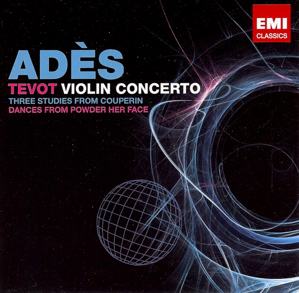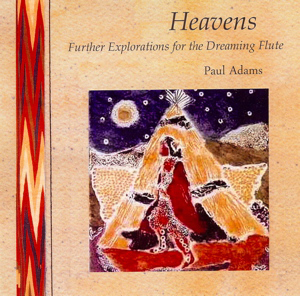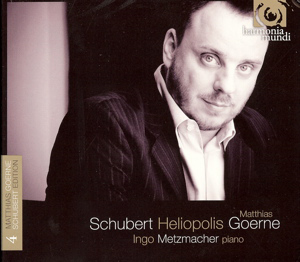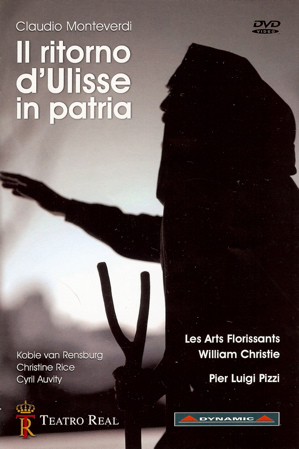
Thomas Adès Tevot, Violin Concerto, Couperin Dances EMI Classics 57813
- Performance:

- Sonics:

Wow. What at trip! I’m sure London-born Thomas Adès must have written some sedate music sometime in his 39 years on the planet, but you won’t hear it on this CD.
EMI Classics’ latest Adès disc begins with Tevot (2007), a 22-minute, single movement wild ride whose beginning brings to mind a weird, otherworldly grinding machine. Adès takes off from the Hebrew definition of tevot, which connotes both musical bars and Biblical arks. In this context, those arks include Noah’s two-of-all and God’s all-of-all, aka the Ark of the Covenant.
Adès has said of the piece, “I liked the idea that the bars of the music were carrying the notes as a sort of family through the piece. And they do, because without bars, you’d have musical chaos. But I was thinking about the ark, the vessel, in the piece as the earth. The earth would be a spaceship, a ship that carries us – and several other species! – through the chaos of space in safety… it’s the idea of the ship of the world.â€
Words are one thing, but this music is something else. Resistance is futile, as it sucks you in and whirls you about. Little high clarinet squeaks contrast with great drama down low, Cataclysms occur, trumpets descend, and drums flute piccolo everything at once join in to create a fantastical universe. We do reach temporary equilibrium ¾ through the piece, when birdsong and a sense of romance emerge. Then comes the big breakthrough. Thanks to Sir Simon Rattle and the Berlin Philharmonic, we are there.
Before we can fully assess where that is, Adès leads violinist Anthony Marwood and the Chamber Orchestra of Europe in his Violin Concerto “Concentric Paths†(2005). Yes, more journeying. The first movement, “Rings,†moves round and round, whirling us about. Next comes “Pathsâ€; its energy temporarily winds down, growing warm and romantic before resuming the search, as if trying to find its way home. There’s a sense of dread in the final movement, “Rounds,†as the energy continues to spiral.
Three Studies from Couperin (2006) reflects Adès love of the French composer’s keyboard music. Performed by Adès and the Chamber Orchestra of Europe, this time in double string orchestra configuration, the pieces sound like Couperin yet entirely different. “Les Amusemens†seems to come from a hazy distance, and the orchestration of “Les Tours de passe-passe†hardly reflects an authentic baroque sound world.
The closer, Adès’ recent 11-minute Overture, Waltz, and Finale from his opera, Powder Her Face (2007), visits more familiar territory. The overture is hilarious, Broadway-like, tipsy and bluesy. The waltz sounds like the Waltz of the Distorted Elves, and owes its inspiration to Mahler. The final tango brings more hilarity. Performed by the National Youth Orchestra of Great Britain, which sounds all grown up under Paul Daniel’s baton, the suite makes a great close to a journey so rich and eventful that you’ll want to take the trip more than once.

Paul Adams Heavens Lakefront 0016
- Performance:

- Sonics:

Sometimes music comes to us at the right time. Shortly before my husband David received word that his aged father, who was bedridden at his home with 24-hour care and extra hospice care, had taken a turn for the worse, Paul Adams’ Heavens: Further Explorations of the Dreaming Flute arrived in the mail. That night, when I put the CD into my computer, and listened to the first few tracks over an excellent, audiophile-level desktop sound system, David was so moved by the music that he urged me to review it.
It was only then that I opened the liner notes and discovered Adams’ dedication “to my mother Paula, her Hospice Care, and the flute that comforted her on her journey home.†If ever I needed validation beyond my own ears and heart that Adams’ music captures the healing essence of transcendent love, and speaks with universal depth and empathy, this was it.
The music of Heavens is as simple and basic as it is soulful. Adams plays wind instruments that come from his exotic collection of flutes, whistles, and Chinese huilusi (also spelled hulusi). These instruments may have a limited range, but Adams’ ability to coax magic from them with his evocative, repetitive melodies is profound. He also has the musical wherewithal to vary timbres and deepen the experience by adding gongs, triangles, zither, percussion, and, on occasion, nature sounds. Beneath the instruments, the voices of the Eagle Ridge singers occasionally integrate into an ambient, quintessentially New Age soundstage whose extremely large, three-dimensional presentation creates an all-enveloping sense of warmth. I just love the giggles of Adams’ daughter Christina heard at the end of the first track, “Dreamtime.â€
Adams has quite the resume. A luthier who has built instruments for Daryl Hall and members of the Stevie Wonder’s band, he has released eight albums in five different genres. That includes two CDs of flute meditations. He also performs in a band, The Neurons, which he started with Ray Charles arranger David Hoffman. The band mixes jazz and world with looped grooves. He also does poetic readings, and has composed commercials for a host of companies, including Chrysler and Subaru.
Adams’ many years working with the mental ill have undoubtedly contributed to the calm depth of the musical explorations on Heaven. They’re quite beautiful, and ideal for meditation, massage, reverie, and blissing out.
“I am lost and so alone,†cried the little man. “How can I find home?â€
â€Follow your music,†replied the old one.
“But I hear so much music. Where is it coming from, and how do I get there?â€
“It is within, within your silence, and in THE HEAVENS,†said the old one.
With those words, taken from the back cover of Adams’ album, I highly recommend this album. Do check out www.pauladams.org.

Hesp̬rion XXI РLa Capella Reial de Catalunya РJordi Savall Le Royaume Oubli̩ * The Forgotten Kingdom * The Albigensian Crusade AliaVox AVSA9873 A/C
- Performance:

- Sonics:

“Leaving myth and legend aside,†write UNESCO “Artist for the Peace†soprano Montserrat Figueras and her viola da gamba master/conductor husband Jordi Savall, “the destruction of the memory of that remarkable civilization which was the ‘land of Oc’, destined to become a truly forgotten kingdom, and the terrible tragedy of the Cathars or ‘Good Men†and their witness to their faith, deserve our unreserved respect and determined effort to preserve their historical memory. Eight centuries have passed, and yet the memory of the crusade against the Albigensians has not been erased. Even today, it evokes sorrow and pity. That is why, in common with François Cheng, we believe that ‘it is our urgent and permanent task to unveil the two mysteries which constitute the extremes of the living world; on the one hand, evil, and on the other, beauty. For what is at stake is no less than the truth of human destiny, a destiny which involves the very foundations of our freedom.â€
Thus does this longtime couple, stalwarts of the early music movement, take an eloquent stand for truth and freedom. In three CDs and an extraordinary 558-page glossy book, presented in seven languages and laid out like a Bible, they present the tragic history of the Cathars. These Christian believers in the existence of two coeternal principles, Good and Evil, came into conflict with official Church doctrine. Labeled heretics (which signifies choosers of a particular opinion that differs from the official line), they were murdered, massacred, and burned at the stake as part of the Crusades launched in 1208 by the ironically titled Pope Innocent III. With the destruction of their homeland, known as Occitania, and of the early troubadour tradition that had blossomed in their towns and villages during the 12th and 13th centuries, humanity, music, and spirit suffered.
Even as the lilt and unusual rhythms of this music entice, most of the tracks are hardly filled with joy. The first CD, “The Emergence and Heyday of Catharism – The Rise of Occitania,†barely begins to dance before, in track 3, drums and duduk memorialize the first burning of heretics at the stake at Orléans and Turin in 1022. Recitation, chant by great Figueras (whose plaintive voice remains beguiling, despite darkening and growing less pliable with age), and instrumental/vocal ensemble tell the tale as the saga proceeds through CD 2, “The Albigensian Crusade – Invasion of Occitania 1204-1228â€, and culminates with CD 3, “Persecution, diaspora and the end of Catharism 1229-1463.†The final track, Savall’s “Homage to the ‘Good Men’, has an eloquent sadness whose parallel can be found in the melodies that developed over millennia of Jewish persecution by the same forces that persecuted the Cathars.
This is a remarkable artistic achievement. At a time when CD sales are slowing, this great couple and their orchestras have gone to great expense to remind us of abominations that we continue to repeat in one bellicose invasion and massacre after another. If the book look likes a Bible, the project itself is a prayer. As Hispanic immigrants become the latest target of those who would purify, a Buddhist paraphrase arises in the mind. May all human beings been free of the suffering imposed by ignorance and intolerance.
The following reviews initially appeared at sfcv.org, the website of San Francisco Classical Voice

Matthias Goerne & Ingo Metzmacher Schubert Heliopolis Harmonia Mundi HMU 902035
- Performance:

- Recording:

Baritone Matthias Goerne, one of the great lieder singers of our age, has now released four volumes in Harmonia Mundi’s ongoing Matthias Goerne Schubert Edition. While the ultimate extent of the project remains unknown – there are no recording sessions scheduled for the remainder of 2010 – the depth of Goerne’s artistry places makes what we already have on the same level of importance as Dietrich Fischer-Dieskau’s many recorded volumes of Schubert songs.
As has been the case with most of Goerne’s recordings, each Schubert volume offers a different accompanist. Ingo Metzmacher, whom Goerne encouraged to temporarily put down his conducting baton, does the honors on the latest installment, Volume 4: Heliopolis. The package includes an illuminating short “bonus†DVD on the making of the recording that reveals Goerne blissfully unrestrained by concert formality.
The CD’s 19 songs abound in references to ancient Greece. “Die Götter Griechenlands†(The Gods of Greece), which sets one stanza of an extended poem by Friedrich Schiller, establishes the tone of longing that predominates in Schubert’s oeuvre. Immediately we feel Goerne’s supreme ability to communicate the most inward and deeply felt of sentiments.
As he softens and sweetens the voice, Goerne communicates a fragile vulnerability that, in turn, reflects Schubert’s sense of impending mortality. And when Metzmacher observes Schubert’s pause at the end of the line that references the shadow, his silence miraculously sustains the musical tension and deepens the emptiness of the phrase.
“Beauteous world, where are you?†sings Goerne at song’s end. The he repeats the question with a quiet depth that embodies the mourning for the past. In twelve lines, the heart is revealed.
While many of the songs on this volume will never make it onto a collection of Schubert’s Greatest Hits, “Meere stille†(Calm sea), “Wandrers Nachtlied I†(the first of Schubert’s two Wanderer’s Night Songs), and “Frühlingsglaube†(Faith in spring) are among the greats. To compare Goerne and Metzmacher’s gorgeous rendition of “Frühlingsglaube†with the far fussier version by Fischer-Dieskau and Gerald Moore in their near-complete Schubert edition can serve as an object lesson in lieder artistry.
Goerne may initially seem far less specific in his word painting, but his subtle changes of volume, color, and tone are no less expressive. Note, for example, the way in which he injects an uplifting sense of hope as his tone blossoms from within on the final lines. The performance, which is rehearsed many times on the DVD, makes for one of the most beautiful and treasurable “Frühlingsglaubes†ever recorded.
“Das Heimweh†(Homesickness) may be too long to win a place in many hearts, but the range of expression Metzmacher brings to the piano introduction makes the best possible case for its inclusion. Similarly, when Goerne proclaims like a God in “An die Leier,†we, or at least I, sit up and take notice.
Volumes could be written about the depth of Goerne’s darker voice, the sweetness of his softly touched top, and the terror of his growl. Honoring one of the finest song composers of any age, he and Metzmacher perform a host of little miracles that together make their recording a profound achievement.

Claudio Monteverdi Il ritorno d’Ulisse in patria Dynamic 33641
- Performance:

- Recording and Picture:

This 2-disc DVD gives the lie to the notion that opera can remain relevant only if the setting is updated to contemporary times. Pier Luigi Pizzi’s historically-based, thoroughly modern sets, costumes, and direction for this 2009 production of Claudio Monteverdi’s Il ritorno d’Ulisse in patria at Teatro Real, Madrid are so compelling, and the authentic instrument performance by William Christie and Les Arts Florissants so alive and colorful, that an opera first performed 369 years ago resounds with life and feeling.
As intelligently directly by Matteo Ricchetti for this Dynamic DVD, Jonathan Cable’s new edition of the opera unfolds on a round stage that connects the players to musicians and audience by means of a long wide stairway that descends from the front of the stage. The sets are sparse – a single bare tree, rocks, a gray sky, a bare barge that arises at appropriate moments, etc – and the simple, draping costumes arrest the eye by exploiting the contrast between off-white, gray, black, and royal red and blue. They also exploit the flesh, with several performers, notably the handsome Ed Lyon (Eurimaco/Glove) and near-diaper clad Terry Wey (Human Fragility), showing more than enough to keep the eye occupied.
Casting pays equal attention to singing and acting capabilities. Here Pizzi and Christie show their expertise, choosing artists who not only negotiate early music’s ornate figures and embellishments with ease, but also look and move their parts. Everything comes together with images so iconic as to drive the compelling humanity of the story deep into the heart.
Heading the cast is handsome, bearded tenor Kobie van Rensburg (Ulisse). While he can certainly sing sweetly at lower volumes, van Rensburg intentionally pushes the voice at key moments, allowing it to grow a bit grainy and gruff for dramatic effect. The sacrifice pays off, as the depth of his characterization evokes empathy for the suffering of the long-exiled King.
Equal moving is the dry, touching mezzo of Christine Rice (Penelope), who portrays the loyal spouse who never abandons hope or betrays her marriage vows. As their son, Cyril Auvity (Telemacco) sings in a sweeter tenor, and jumps about the stage with the energy of youth. (Roberto Maria Pizzuto’s choreography is quite effective). The other characters, from Penelope’s seductive maid to Iro the glutton, look and sound their parts.
Intelligently edited interviews with Rice, van Rensburg, and Christie cast further light on the production. Rice speaks of ample rehearsal time, and how Christie began preparations by having the singer/actors declaim rather than sing the words. This made especial sense for the character of Penelope, whom Monteverdi restricts almost entirely to recitative for dramatic effect. Van Rensburg stresses the “wonderful humanity†of the characters, and notes that Monteverdi writes so skillfully that he even succeeds in holding interest as five tenors appear together onstage. And Christie explains that, instead of waving a baton, he welcomed the opportunity to play keyboard and allow the musicians to conduct and improvise as they saw fit.
This DVD serves as a model of what an intelligent approach to early music can achieve. Bravo.


